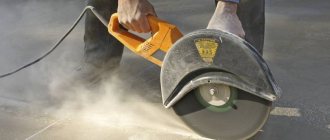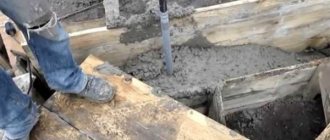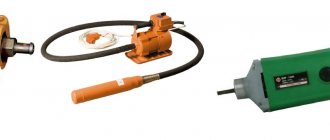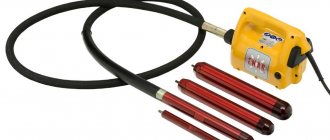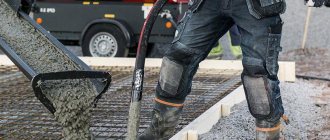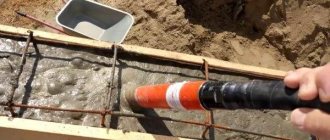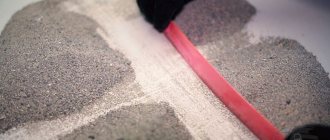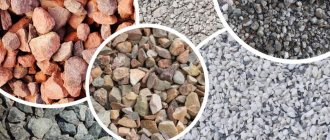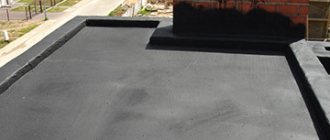Home |Technique and materials |Do-it-yourself deep vibrator for concrete
Date: May 23, 2017
Comments: 0
Concrete is widely used in construction and repair work. The material is indispensable due to its increased strength and reliability, which allows concrete structures to be used for a long time. An internal vibrator for concrete helps to ensure a homogeneous structure of the monolith, compacting the solution and removing air inclusions from the mass.
Today there are many types of vibration compactors available. Their purchase is advisable if concrete is poured in significant volumes. With small foundation dimensions, using available power tools and available materials, you can save financial resources and make a concrete vibrator with your own hands. Such a device will practically not differ in operating efficiency from its factory counterpart.
Let us dwell on the principle of operation, purpose, types and technical characteristics of the device. Let's consider recommendations for self-production.
Since air still gets in when mixing and laying the solution, you have to remove it with something
Why do you need a deep concrete vibrator?
During the mixing process, the concrete solution is actively saturated with air. This reduces the strength characteristics of concrete structures and negatively affects the reliability and service life. You can avoid negative factors if you use a submersible vibrator, the main functions of which are:
- ensuring a uniform consistency of the concrete solution;
- elimination of air cavities in the thickness of the massif;
- removing excess moisture from the concrete composition;
- increasing the strength characteristics of the material.
After vibration compaction, the plasticity and compliance of the concrete composition increases. The intensity of concrete shrinkage also increases and the curing time is reduced.
Operating principle
In formwork with reinforcement filled with concrete, it is problematic to mix the solution manually. Using a steel rod to “bayonet” a concrete mass does not bring the desired effect. There is a need to use a device that transmits high-frequency vibrations to the solution.
To remove air and improve the connection between concrete particles - these are the tasks that a construction vibrator performs
Based on the principle of impact on concrete mortar, devices are divided into types:
- Submersible-type vibration compactors (deep), which transmit high-frequency vibrations to the concrete mass through the body of the submersible nozzle.
- External platform-type devices placed on the formwork that transmit vibration to the concrete mass.
- Surface devices, the vibration from which is transmitted to a specific work area where the concrete solution is laid.
A submersible device that creates high-frequency oscillations in the thickness of the massif is widely used.
The operating feature of the vibrating compactor, which implements this principle, is based on the removal of air bubbles from the concrete solution. A high-frequency vibrator transmits vibration energy to the concrete through the working element, mixing it. Lighter air bubbles tend to rise outward. This increases the moisture resistance of the monolith, relieves internal stress, and reduces the likelihood of shell formation.
Deep vibrator device
The submersible vibration compactor of the electromechanical type is designed quite simply. It consists of the following parts:
- an electric motor, which is a source of energy;
Submersible Portable Concrete Vibrator
- a flexible shaft that acts as a transmission mechanism;
- a generator attachment that creates high-frequency vibrations.
The vibrating tip can have the following shape:
- Cylindrical. This attachment is called a vibrating mace and is used when the solution is of normal thickness.
- Conical. The tip is a vibrating bayonet used to compact thick mixtures.
The working part may include:
- group of vibration attachments;
- vibration tips of various diameters;
- one or more vibrating bayonets.
The main elements of the vibrating attachment:
- Cylindrical body made of stainless steel pipe.
- Roller bearings centering the flexible shaft.
- A bushing that converts rotation into vibrations.
Incorrect use of vibration will not only bring no benefit, but can also cause harm: excessive duration of exposure will cause stratification of the solution, which will negatively affect its strength
Submersible vibrator - varieties
Submersible type vibration compactors differ in their design features. Applicable:
- electromechanical devices operating from a motor with a supply voltage of 220 or 380 V and a frequency of 50 Hz. Torque through a flexible shaft 1.5–6 m long is converted into vibration of the working body;
- high frequency vibration compactors driven by a motor with a frequency of up to 200 Hz. The voltage converter reduces the motor power to 42 V and ensures the safety of concrete work;
- vibrating compactors with hydraulic drive. A design nuance is the adjustment of the oscillation frequency of the hydraulic motor, which develops pressure up to 120 bar;
- pneumatic devices controlled by a pneumatic motor using a release valve. The devices are easy to maintain and are used in the production of reinforced concrete products;
- electromagnetic type vibrators. A constant frequency of oscillation is created by a spring-loaded armature using an electric magnet. The amplitude of oscillations is affected by the weight of the armature and the elasticity of the springs.
Based on size and performance, devices are divided into the following types:
- Small-sized vibration compactors with low productivity. They are used in the construction of private facilities.
- Standard vibration compactors with vibration frequencies up to 20 thousand per minute. Used in industrial construction.
A high-frequency vibrator is widely used, providing effective compaction of the concrete mass due to its increased efficiency.
High frequency deep vibrator
Types of vibration equipment
Deep vibrator for compacting concrete mixtures.
The classification of vibration machines consists of three types.
- Surface compression devices transmit vibrations from the top layer of liquid pulp. These include metal vibrating plates, vibrating slats, weights connected to the vibrator. These mechanisms are placed on the surface of the mortar being compacted. Equipment is used at construction sites, during road construction, to compress reinforced concrete structures up to 2 dm thick, but with a large area. Weights are designed for use on moving platforms to compact cement simultaneously from above and below. Among the surface compression tools there are vibrating attachments and vibration smoothing mechanisms. With their help, additional compaction is carried out. To vibrate concrete, attachments and cassette installations are used.
- Depth compactors are completely immersed in the mold. These include vibration exciters. These mechanisms are used on construction sites in the manufacture of massive products. This category of devices includes vibration void formers.
- Volumetric tamper vibrators transmit oscillatory movements to the entire mold containing the solution. This device is called a vibrating plate. Vibrating platforms are divided into several types: with horizontal and vertical vibrations, with moving frames and blocks. Such vibration equipment is intended for compacting a variety of loose and non-cohesive soils, paving slabs, as well as for repair work on the road surface.
We suggest you familiarize yourself with: DIY concrete vibrator, how to make it, homemade deep concrete vibrator
High-frequency vibrator – features of choice and characteristics
When choosing a vibrator for concrete compaction, you should consider several factors:
- nature of construction work;
- features of reinforced concrete structures;
- depth of the concrete mass;
- mesh size of the reinforcement mesh.
For example, to compact a slab-type base with a small thickness, it is enough to use a device with an intermediate shaft of up to 3 m. If the depth of the formwork filled with concrete exceeds 2 m, you will need a vibration compactor with a shaft up to 5 meters long. The diameter of the vibrating tip should be 50% smaller than the mesh size of the reinforcement mesh. This will ensure the necessary penetration of the nozzle and reduce the likelihood of contact with the reinforcement.
The characteristics of deep-hole devices powered by an alternating voltage network differ in the following parameters:
- Supply voltage (220 or 380 V).
- Availability of a residual current device.
- Electric motor power (from 1 to 1.5 kW).
- The frequency of vibrations created by the working body (12–20 thousand rpm).
- Performance depending on motor power and oscillation frequency.
- The length of the intermediate shaft, if necessary, is up to 10 m.
The most effective are high frequency
Practical use
Basic requirements when working with a vibrator:
The mace of this device should be immersed in the solution only vertically.
- It is recommended to lower the vibrator into the cement layer so that the vibration sites intersect.
- The vibrator is immersed vertically no less than 1/3 of its length.
- The device must be smoothly removed from the solution.
- The execution process and time interval of actions depends on the size of the tip and the quality of the mixture. For cement mortar of a thicker consistency, vibrate thoroughly and for a long time.
- The device must not touch reinforcement elements or formwork parts.
- Do not start the vibrator without immersion.
- If a phased filling is carried out, then the layer thickness is less than 0.5 m.
To compact concrete into the mixture laid and leveled in the form, the builder immerses the tip in a strictly vertical position. Otherwise it will fail. The vibrating tip penetrates into the thickness due to its weight (from 3.5 to 9 kg). Process each area slowly (8 cm per second), pulling it to the surface to fill the space that had air bubbles with the cement mixture. If you do not use a vibrator, the concrete surface will turn out to be loose, unstable to vibration, loads and temperature changes.
How to make a vibrator for concrete with your own hands
For self-production, you can use one of the following devices:
- electric drill;
- small hammer drill with power up to 1.5 kW.
Make a submersible vibrator according to the first option by preparing the following equipment and components:
- Electric drill with a power of 0.65–1.0 kW.
- Welding machine with electrodes.
- A hacksaw for metal.
- Stainless steel pipe with a diameter of 40–45 mm.
- Steel rod with a diameter of 12–15 mm.
- Flexible cable in a waterproofed casing of the required length.
- Bearings in the amount of 2 pieces, corresponding to the internal diameter of the pipe and the dimensions of the steel rod.
A construction vibrator can be made on the basis of any power tool with an adjustable speed
Carry out manufacturing following the sequence of operations:
- Cut a piece of pipe 450–550 mm long.
- Weld an eccentric at the end of the steel rod.
- Install bearings onto the rod with weighting material.
- Insert the assembled assembly into the pipe.
- Weld the end of the pipe.
- Seal the tip exit.
- Connect the cable to the attachment and drill.
The principle of operation of the device is to convert the rotational movement of the flexible shaft into vibrations of the nozzle thanks to the installed eccentric. By adjusting the speed of the electric drill, you can change the amplitude of the oscillations.
For manufacturing, you can use a hammer drill. Required:
- steel pike;
- support washer.
The length of the peak is selected depending on the depth of the formwork. A washer is welded at the end of the rod.
The device is operated in rebound mode. A rod with a washer installed in the hammer drill cartridge rests on the bottom of the formwork and transmits vibrations to the concrete mass. Using a hammer drill with an attachment, it is easy to process significant volumes of solution in a limited time.
Process Benefits
The compaction process in concrete has a number of advantages:
- Vibration reduces the porosity of concrete stone. As is known, voids in liquid pulp account for 1-2%. If they are not removed, they will fill with air and the cement will lose strength and water resistance. Vibration effects can solve this problem. High-frequency mechanical vibrations with low amplitude increase the mobility of the liquid pulp, which causes the outflow of air bubbles.
- Vibration vibrations make it possible to increase the viscosity of the sand concrete mass and prevent delamination. Thus, the finished concrete stone will be more uniform. In addition, oscillatory movements increase the fluidity of the liquid mass, which allows it to more evenly fill the formwork shape. Vibrating concrete allows you to obtain a ready-made product that is resistant to cracking, mechanical stress, seasonal temperature fluctuations and other negative environmental factors, with an increased service life.
The process of applying oscillatory pulses has clear rules that must be followed in order to achieve a good result.
- It is recommended to immerse the oscillating device to 80% of its length. This allows you to qualitatively mix the lower and upper layers of the conglomerate.
- The entire concrete composition must be subjected to vibration. The area of action of the tool should be located so that the wave from its operation covers the entire solution.
- Contact of the pins with the reinforcement should be avoided. It is recommended to place the vibrator at some distance so that the space around the metal element is not free.
- It is not recommended to insert the vibrator close to the edge, to joints and corners.
- There should be no crater left after removing the mechanism.
Compacting concrete by deep vibration.
By submerged vibrators or by exciting the cement-sand mass, oscillatory movements are transmitted through the formwork or mold. As a result of this, the particles of the mass components receive impulses, and the mixture itself acquires the properties of a heavy liquid, that is, it liquefies, this is correct. In this case, vibration reduces or completely destroys contacts between particles and weakens internal friction. This action removes excess air from the cement, making it easier for it to fill the molds.
Oscillation frequency is the main parameter. It can vary over a wide range and is determined by the type of vibrator. The vibration frequency has different effects on filler particles of different sizes. Before vibrating concrete, you should carefully select the tool depending on the size of the filler.


